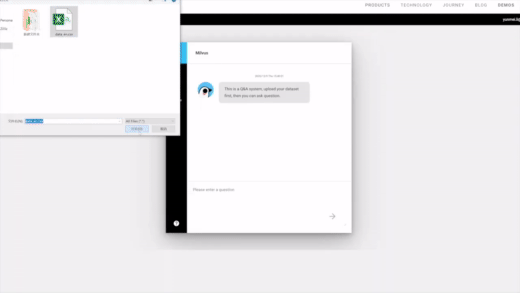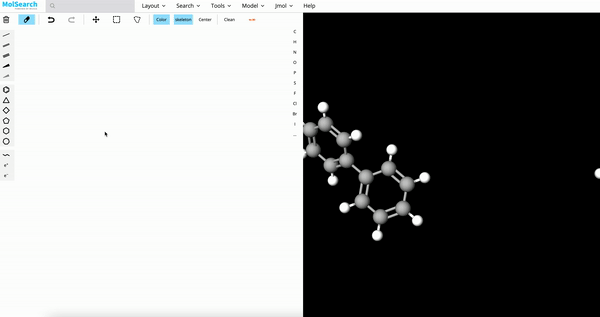 milvus
milvus
Milvus is a high-performance, cloud-native vector database built for scalable vector ANN search
Top Related Projects
Qdrant - High-performance, massive-scale Vector Database and Vector Search Engine for the next generation of AI. Also available in the cloud https://cloud.qdrant.io/
Weaviate is an open-source vector database that stores both objects and vectors, allowing for the combination of vector search with structured filtering with the fault tolerance and scalability of a cloud-native database.
the AI-native open-source embedding database
Free and Open Source, Distributed, RESTful Search Engine
AI + Data, online. https://vespa.ai
Quick Overview
Milvus is an open-source vector database designed for managing and searching large-scale vector data. It is built to power AI applications and support similarity search at scale. Milvus offers high performance, scalability, and ease of use for handling embedding vectors generated by machine learning models.
Pros
- High performance and scalability for similarity search on large datasets
- Supports multiple index types and distance metrics for diverse use cases
- Integrates well with popular AI frameworks and tools
- Offers both standalone and distributed deployment options
Cons
- Steep learning curve for beginners unfamiliar with vector databases
- Limited support for complex queries compared to traditional relational databases
- Requires careful tuning and configuration for optimal performance
- Documentation can be inconsistent or outdated in some areas
Code Examples
- Creating a collection and inserting vectors:
from pymilvus import Collection, FieldSchema, CollectionSchema, DataType
# Define collection schema
fields = [
FieldSchema("id", DataType.INT64, is_primary=True),
FieldSchema("embedding", DataType.FLOAT_VECTOR, dim=128)
]
schema = CollectionSchema(fields)
# Create collection
collection = Collection("my_collection", schema)
# Insert vectors
entities = [
[1, 2, 3], # ids
[[1.0, 2.0, ..., 128.0], [2.0, 3.0, ..., 129.0], [3.0, 4.0, ..., 130.0]] # embeddings
]
collection.insert(entities)
- Performing a vector similarity search:
# Search for similar vectors
search_params = {"metric_type": "L2", "params": {"nprobe": 10}}
results = collection.search(
data=[[1.0, 2.0, ..., 128.0]], # query vector
anns_field="embedding",
param=search_params,
limit=5,
expr=None
)
# Process results
for hits in results:
for hit in hits:
print(f"ID: {hit.id}, Distance: {hit.distance}")
- Creating an index for faster searches:
# Create an IVF_FLAT index
index_params = {
"metric_type": "L2",
"index_type": "IVF_FLAT",
"params": {"nlist": 1024}
}
collection.create_index("embedding", index_params)
Getting Started
To get started with Milvus:
-
Install Milvus using Docker:
docker compose up -d -
Install the Python client:
pip install pymilvus -
Connect to Milvus:
from pymilvus import connections connections.connect("default", host="localhost", port="19530") -
Create a collection, insert data, and perform searches as shown in the code examples above.
For more detailed instructions, refer to the official Milvus documentation.
Competitor Comparisons
Qdrant - High-performance, massive-scale Vector Database and Vector Search Engine for the next generation of AI. Also available in the cloud https://cloud.qdrant.io/
Pros of Qdrant
- Written in Rust, offering high performance and memory safety
- Supports filtering during search, allowing for more precise queries
- Provides a simple and intuitive API for vector search operations
Cons of Qdrant
- Smaller community and ecosystem compared to Milvus
- Limited support for distributed deployments and scalability
- Fewer indexing algorithms and data types supported
Code Comparison
Qdrant (Python client):
from qdrant_client import QdrantClient
client = QdrantClient("localhost", port=6333)
client.search(
collection_name="my_collection",
query_vector=[0.2, 0.1, 0.9, 0.7],
limit=5
)
Milvus (Python client):
from milvus import Milvus, IndexType, MetricType
milvus = Milvus(host='localhost', port='19530')
status, results = milvus.search(
collection_name="my_collection",
query_records=[[0.2, 0.1, 0.9, 0.7]],
top_k=5,
params={"nprobe": 16}
)
Both libraries offer straightforward APIs for vector search operations, but Milvus provides more advanced configuration options and supports a wider range of index types and metrics.
Weaviate is an open-source vector database that stores both objects and vectors, allowing for the combination of vector search with structured filtering with the fault tolerance and scalability of a cloud-native database.
Pros of Weaviate
- Built-in GraphQL API for easy querying and data manipulation
- Supports multiple vector index types (HNSW, LSH, FAISS)
- Modular architecture with pluggable modules for different functionalities
Cons of Weaviate
- Smaller community and ecosystem compared to Milvus
- Limited support for distributed deployments and scaling
Code Comparison
Milvus (Python client):
from pymilvus import Collection, connections
connections.connect()
collection = Collection("example")
results = collection.search(
data=[[1.0, 2.0, 3.0]],
anns_field="vector_field",
param={"metric_type": "L2", "params": {"nprobe": 10}},
limit=5
)
Weaviate (Python client):
import weaviate
client = weaviate.Client("http://localhost:8080")
results = client.query.get("Example", ["field1", "field2"]).with_near_vector({
"vector": [1.0, 2.0, 3.0]
}).with_limit(5).do()
Both repositories offer vector similarity search capabilities, but they differ in their approach and features. Milvus focuses on high-performance vector indexing and searching, while Weaviate provides a more comprehensive data object storage solution with built-in GraphQL support. The code examples demonstrate the different query styles and client interactions for each system.
the AI-native open-source embedding database
Pros of Chroma
- Simpler setup and usage, ideal for smaller-scale projects
- Built-in support for various embedding models
- More lightweight and easier to integrate into existing Python projects
Cons of Chroma
- Limited scalability compared to Milvus for large-scale vector search
- Fewer advanced features and customization options
- Less mature ecosystem and community support
Code Comparison
Chroma:
import chromadb
client = chromadb.Client()
collection = client.create_collection("my_collection")
collection.add(documents=["doc1", "doc2"], metadatas=[{"source": "a"}, {"source": "b"}], ids=["id1", "id2"])
results = collection.query(query_texts=["query"], n_results=2)
Milvus:
from pymilvus import Collection, connections
connections.connect()
collection = Collection("my_collection")
collection.insert([["doc1", "doc2"], [{"source": "a"}, {"source": "b"}]])
results = collection.search(data=["query"], anns_field="vector_field", param={}, limit=2)
Both Chroma and Milvus offer vector database solutions, but they cater to different use cases. Chroma is more suitable for smaller projects and quick integrations, while Milvus excels in large-scale, high-performance vector search applications. The code examples demonstrate the simplicity of Chroma's API compared to Milvus' more detailed configuration options.
Free and Open Source, Distributed, RESTful Search Engine
Pros of Elasticsearch
- Mature and widely adopted full-text search engine with extensive documentation
- Powerful query language (DSL) for complex searches and aggregations
- Supports a wide range of data types and use cases beyond vector search
Cons of Elasticsearch
- Less optimized for high-dimensional vector search compared to Milvus
- Can be resource-intensive and complex to set up and maintain at scale
- Limited support for advanced vector indexing algorithms like HNSW
Code Comparison
Elasticsearch (indexing a vector):
PUT /my-index/_doc/1
{
"my_vector": [1.5, 2.5, 3.5, 4.5, 5.5]
}
Milvus (inserting vectors):
collection.insert([
[1.5, 2.5, 3.5, 4.5, 5.5],
[2.5, 3.5, 4.5, 5.5, 6.5]
])
Both Elasticsearch and Milvus are powerful tools for search and data storage, but they have different strengths. Elasticsearch excels in full-text search and general-purpose document storage, while Milvus is specifically designed for efficient vector similarity search. The choice between them depends on the specific requirements of your project, such as the type of data you're working with and the scale of vector operations needed.
AI + Data, online. https://vespa.ai
Pros of Vespa
- More comprehensive search and recommendation capabilities, including real-time big data serving and content-based ranking
- Built-in support for machine learning model serving and online feature computation
- Flexible schema-less data model allowing for easy integration of structured and unstructured data
Cons of Vespa
- Steeper learning curve due to its more complex architecture and broader feature set
- Higher resource requirements for deployment and operation, especially for smaller-scale applications
- Less focused on vector similarity search compared to Milvus' specialized approach
Code Comparison
Milvus (Python client):
from milvus import Milvus, IndexType, MetricType
client = Milvus(host='localhost', port='19530')
client.create_collection('example', dimension=128, index_type=IndexType.IVF_FLAT, metric_type=MetricType.L2)
Vespa (Application package):
<schema>
<document type="example">
<field name="id" type="string" indexing="summary | attribute"/>
<field name="embedding" type="tensor<float>(x[128])" indexing="attribute | index"/>
</document>
</schema>
Convert  designs to code with AI
designs to code with AI

Introducing Visual Copilot: A new AI model to turn Figma designs to high quality code using your components.
Try Visual CopilotREADME
What is Milvus?
ð¦ Milvus is a high-performance vector database built for scale. It powers AI applications by efficiently organizing and searching vast amounts of unstructured data, such as text, images, and multi-modal information.
ð§âð» Written in Go and C++, Milvus implements hardware accelaration for CPU/GPU to achieve best-in-class vector search performance. Thanks to its fully-distributed and K8s-native architecture, Milvus can scale horizontally, handle tens of thousands of search queries on billions of vectors, and keep data fresh with real-time streaming updates. Milvus also supports Standalone mode for single machine deployment. Milvus Lite is a lightweight version good for quickstart in python with pip install.
Want to use Milvus with zero setup? Try out Zilliz Cloud âï¸ for free. Milvus is available as a fully managed service on Zilliz Cloud, with Serverless, Dedicated and BYOC options available.
For questions about how to use Milvus, join the community on Discord to get help. For reporting problems, file bugs and feature requests in GitHub Issues or ask in Discussions.
The Milvus open-source project is under LF AI & Data Foundation, distributed with Apache 2.0 License, with Zilliz as its major contributor.
Quickstart
$ pip install -U pymilvus
This installs pymilvus, the Python SDK for Milvus. Use MilvusClient to create a client:
from pymilvus import MilvusClient
-
pymilvusalso includes Milvus Lite for quickstart. To create a local vector database, simply instantiate a client with a local file name for persisting data:client = MilvusClient("milvus_demo.db") -
You can also specify the credentials to connect to your deployed Milvus server or Zilliz Cloud:
client = MilvusClient( uri="<endpoint_of_self_hosted_milvus_or_zilliz_cloud>", token="<username_and_password_or_zilliz_cloud_api_key>")
With the client, you can create collection:
client.create_collection(
collection_name="demo_collection",
dimension=768, # The vectors we will use in this demo have 768 dimensions
)
Ingest data:
res = client.insert(collection_name="demo_collection", data=data)
Perform vector search:
query_vectors = embedding_fn.encode_queries(["Who is Alan Turing?", "What is AI?"])
res = client.search(
collection_name="demo_collection", # target collection
data=query_vectors, # a list of one or more query vectors, supports batch
limit=2, # how many results to return (topK)
output_fields=["vector", "text", "subject"], # what fields to return
)
Why Milvus
Milvus is designed to handle vector search at scale. It stores vectors, which are learned representations of unstructured data, together with other scalar data types such as integers, strings, and JSON objects. Users can conduct efficient vector search with metadata filtering or hybrid search. Here are why developers choose Milvus as the vector database for AI applications:
High Performance at Scale and High Availability
- Milvus features a distributed architecture that separates compute and storage. Milvus can horizontally scale and adapt to diverse traffic patterns, achieving optimal performance by independently increasing query nodes for read-heavy workload and data node for write-heavy workload. The stateless microservices on K8s allow quick recovery from failure, ensuring high availability. The support for replicas further enhances fault tolerance and throughput by loading data segments on multiple query nodes. See benchmark for performance comparison.
Support for Various Vector Index Types and Hardware Acceleration
- Milvus separates the system and core vector search engine, allowing it to support all major vector index types that are optimized for different scenarios, including HNSW, IVF, FLAT (brute-force), SCANN, and DiskANN, with quantization-based variations and mmap. Milvus optimizes vector search for advanced features such as metadata filtering and range search. Additionally, Milvus implements hardware acceleration to enhance vector search performance and supports GPU indexing, such as NVIDIA's CAGRA.
Flexible Multi-tenancy and Hot/Cold Storage
- Milvus supports multi-tenancy through isolation at database, collection, partition, or partition key level. The flexible strategies allow a single cluster to handle hundreds to millions of tenants, also ensures optimized search performance and flexible access control. Milvus enhances cost-effectiveness with hot/cold storage. Frequently accessed hot data can be stored in memory or on SSDs for better performance, while less-accessed cold data is kept on slower, cost-effective storage. This mechanism can significantly reduce costs while maintaining high performance for critical tasks.
Sparse Vector for Full Text Search and Hybrid Search
- In addition to semantic search through dense vector, Milvus also natively supports full text search with BM25 as well as learned sparse embedding such as SPLADE and BGE-M3. Users can store sparse vector and dense vector in the same collection, and define functions to rerank results from multiple search requests. See examples of Hybrid Search with semantic search + full text search.
Data Security and Fine-grain Access Control
- Milvus ensures data security by implementing mandatory user authentication, TLS encryption, and Role-Based Access Control (RBAC). User authentication ensures that only authorized users with valid credentials can access the database, while TLS encryption secures all communications within the network. Additionally, RBAC allows for fine-grained access control by assigning specific permissions to users based on their roles. These features make Milvus a robust and secure choice for enterprise applications, protecting sensitive data from unauthorized access and potential breaches.
Milvus is trusted by AI developers to build applications such as text and image search, Retrieval-Augmented Generation (RAG), and recommendation systems. Milvus powers many mission-critical business for startups and enterprises.
Demos and Tutorials
Here is a selection of demos and tutorials to show how to build various types of AI applications made with Milvus:
You can explore a comprehensive Tutorials Overview covering topics such as Retrieval-Augmented Generation (RAG), Semantic Search, Hybrid Search, Question Answering, Recommendation Systems, and various quick-start guides. These resources are designed to help you get started quickly and efficiently.
| Tutorial | Use Case | Related Milvus Features |
|---|---|---|
| Build RAG with Milvus | RAG | vector search |
| Advanced RAG Optimizations | RAG | vector search, full text search |
| Full Text Search with Milvus | Text Search | full text search |
| Hybrid Search with Milvus | Hybrid Search | hybrid search, multi vector, dense embedding, sparse embedding |
| Image Search with Milvus | Semantic Search | vector search, dynamic field |
| Multimodal Search using Multi Vectors | Semantic Search | multi vector, hybrid search |
| Movie Recommendation with Milvus | Recommendation System | vector search |
| Graph RAG with Milvus | RAG | graph search |
| Contextual Retrieval with Milvus | Quickstart | vector search |
| Vector Visualization | Quickstart | vector search |
| HDBSCAN Clustering with Milvus | Quickstart | vector search |
| Use ColPali for Multi-Modal Retrieval with Milvus | Quickstart | vector search |

|

|

|
| Image Search | RAG | Drug Discovery |
|---|
Ecosystem and Integration
Milvus integrates with a comprehensive suite of AI development tools, such as LangChain, LlamaIndex, OpenAI and HuggingFace, making it an ideal vector store for GenAI applications such as Retrieval-Augmented Generation (RAG). Milvus works with both open-source embedding models and embedding service, in text, image and video modalities. Milvus also provides a convenient util pymilvus[model], users can use the simple wrapper code to transform unstructured data into vector embeddings and leverage reranking models for optimized search results. The Milvus ecosystem also includes Attu for GUI-based administration, Birdwatcher for system debugging, Prometheus/Grafana for monitoring, Milvus CDC for data synchronization, VTS for data migration and data connectors for Spark, Kafka, Fivetran, and Airbyte to build search pipelines.
Check out https://milvus.io/docs/integrations_overview.md for more details.
Documentation
For guidance on installation, usage, deployment, and administration, check out Milvus Docs. For technical milestones and enhancement proposals, check out issues on GitHub.
Contributing
The Milvus open-source project accepts contribution from everyone. See Guidelines for Contributing for details on submitting patches and the development workflow. See our community repository to learn about project governance and access more community resources.
Build Milvus from Source Code
Requirements:
-
Linux systems (Ubuntu 20.04 or later recommended):
go: >= 1.21 cmake: >= 3.26.4 gcc: 9.5 python: > 3.8 and <= 3.11 -
MacOS systems with x86_64 (Big Sur 11.5 or later recommended):
go: >= 1.21 cmake: >= 3.26.4 llvm: >= 15 python: > 3.8 and <= 3.11 -
MacOS systems with Apple Silicon (Monterey 12.0.1 or later recommended):
go: >= 1.21 (Arch=ARM64) cmake: >= 3.26.4 llvm: >= 15 python: > 3.8 and <= 3.11
Clone Milvus repo and build.
# Clone github repository.
$ git clone https://github.com/milvus-io/milvus.git
# Install third-party dependencies.
$ cd milvus/
$ ./scripts/install_deps.sh
# Compile Milvus.
$ make
For full instructions, see developer's documentation.
Community
Join the Milvus community on Discord to share your suggestions, advice, and questions with our engineering team.
To learn latest news about Milvus, follow us on social media:
You can also check out our FAQ page to discover solutions or answers to your issues or questions, and subscribe to Milvus mailing lists:
Reference
Reference to cite when you use Milvus in a research paper:
@inproceedings{2021milvus,
title={Milvus: A Purpose-Built Vector Data Management System},
author={Wang, Jianguo and Yi, Xiaomeng and Guo, Rentong and Jin, Hai and Xu, Peng and Li, Shengjun and Wang, Xiangyu and Guo, Xiangzhou and Li, Chengming and Xu, Xiaohai and others},
booktitle={Proceedings of the 2021 International Conference on Management of Data},
pages={2614--2627},
year={2021}
}
@article{2022manu,
title={Manu: a cloud native vector database management system},
author={Guo, Rentong and Luan, Xiaofan and Xiang, Long and Yan, Xiao and Yi, Xiaomeng and Luo, Jigao and Cheng, Qianya and Xu, Weizhi and Luo, Jiarui and Liu, Frank and others},
journal={Proceedings of the VLDB Endowment},
volume={15},
number={12},
pages={3548--3561},
year={2022},
publisher={VLDB Endowment}
}
Top Related Projects
Qdrant - High-performance, massive-scale Vector Database and Vector Search Engine for the next generation of AI. Also available in the cloud https://cloud.qdrant.io/
Weaviate is an open-source vector database that stores both objects and vectors, allowing for the combination of vector search with structured filtering with the fault tolerance and scalability of a cloud-native database.
the AI-native open-source embedding database
Free and Open Source, Distributed, RESTful Search Engine
AI + Data, online. https://vespa.ai
Convert  designs to code with AI
designs to code with AI

Introducing Visual Copilot: A new AI model to turn Figma designs to high quality code using your components.
Try Visual Copilot




